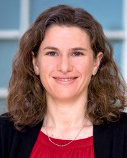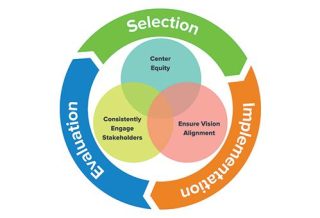FOCUS
Open source for opening minds
New OpenSciEd materials support science standards
By Katherine L. McNeill and Brian J. Reiser
Categories: College- and career-ready standards, Instructional materials/curriculumDecember 2018
Vol. 39 No. 6
It is an exciting time for science education. Many states have adopted new standards guided by the National Research Council’s Framework for K-12 Science (National Research Council, 2012), either the Next Generation Science Standards (Next Generation Science Standards Lead States, 2013) or standards developed according to these National Research Council guidelines.
More than 60% of U.S. school children are being educated in states in which Next Generation Science Standards or other framework-derived standards have been adopted. This vision demands a central role for students to engage in science and engineering practices to build and use science ideas, rather than solely learning about the science others have done (Schwarz, Passmore, & Reiser, 2017).
These new standards cannot be achieved by a teacher telling students science vocabulary and providing facts and explanations that students need to memorize. Instead, teachers need to guide students as they actively engage in rich science investigations and discourse as they reason about the world around them.
Furthermore, this new vision supports an equity vision for science instruction in which all students are known, heard, and supported with access and opportunities for rich science learning.
For these shifts to occur in K-12 science classrooms, teachers need to use new kinds of instructional materials that can support the new approaches. Instructional materials that align with the vision of the Next Generation Science Standards can better support student learning of core science ideas and science practices (Harris et al., 2015). However, instructional materials alone, without sufficient teacher professional learning, do not result in significant changes in classroom instruction (National Research Council, 2015).
“What I learned from this curriculum — and what will ultimately make my teaching better — is that the kids really can guide where they are going. … [They] will be more invested as a result, and they will really come to realize how science works.”
— Middle school science teacher
Teachers enact instructional materials in a variety of ways and need support for instructional transformation in their classrooms that aligns with recent reform efforts (McNeill, González-Howard, Katsh-Singer, & Loper, 2017). High-quality instructional materials combined with professional learning, embedded and sustained in teaching practice, are both needed to support the ambitious vision in recent science standards.
A STORYLINE APPROACH
OpenSciEd is a partnership of 10 states, a consortium of curriculum developers, and science education leaders and experts working to create a complete set of robust, research-based, open-source, K-12 science instructional materials and professional learning supports to increase accessibility for all teachers and students (www.openscied.org). The instructional materials are being designed not as stand-alone units but as a full coherent sequence that builds across units and across years.
A field test for the first three units, one each in 6th, 7th, and 8th grade, began in summer 2018. To support the enactment of these units, OpenSciEd led in-person professional learning for 339 educators from 98 school districts, conducted in 10 locations, one in each of the 10 partner states participating in the field test.
The professional development occurred as four consecutive days of seven hours of instructional time per day, focused on experiencing, analyzing, and preparing to teach with OpenSciEd instructional materials. After the professional learning, 93% of the teachers reported that the OpenSciEd instructional materials are more likely to help their students meet their state standards compared to their current units.
OpenSciEd units are based on the idea of a science storyline (Reiser, Novak, & McGill, 2017). A storyline is a coherent sequence of lessons in which each step is driven by students’ questions that arise from their interactions with phenomena.
At each step, students make progress on the classroom’s questions through science and engineering practices to figure out a piece of a science idea. Each piece they figure out adds to the developing explanation, model, or designed solution. Each step may also generate questions that lead to the next step in the storyline.
Together, what students figure out helps explain the unit’s phenomena or solve the problems they have identified. A storyline provides a coherent path toward building science ideas, piece by piece, anchored in students’ own questions.
This approach highlights two key instructional shifts in the Next Generation Science Standards that are typically absent from traditional science instruction: phenomena-based teaching and the importance of coherence.
Begin with an anchoring phenomenon. Each OpenSciEd unit kicks off with an anchoring phenomenon that motivates student learning throughout the unit. The anchoring phenomenon provides a common experience for every student that leads to questions or challenges. Even everyday phenomena, like the ice in a cold drink melting, can be seen as puzzling when teachers help students see what they cannot explain about how and why this happens.
This approach differs from traditional science units, which start with teachers introducing the science idea, often with scientific terminology: “We are about to start a unit on thermal energy” or “The focus in this unit is on metabolic reactions.”
Instead, students experience the phenomenon of a cold drink warming up and realize they cannot explain scientifically why this happens. This grounds a lesson about thermal energy, in which students are asked to design a cup to keep a drink cold.
Similarly, in a metabolic reactions unit, students are introduced to the case of a 13-year-old girl who is experiencing a strange combination of symptoms, including losing weight, stomach problems, and low energy. As the unit proceeds, students conduct investigations to try to figure out what is causing these symptoms. These investigations require first understanding what normally happens to food and how people get energy.
Part of working with anchoring phenomena also involves asking students to draw on their own personal experiences that seem relevant. In thermal energy, students often bring up other experiences that either keep things cold (e.g. cooler, insulations in walls of a house) or warm (e.g. winter coat, pizza box, sleeping bag).
In metabolic reactions, students can bring up other experiences with the human body (e.g. food poisoning, Lyme disease, asthma). This helps students see science as something related to their lives and experiences, not just disconnected (and sometimes intimidating) academic language like “thermal energy” and “metabolic reactions.”
Support coherence from the students’ perspective. Coherence in OpenSciEd instructional materials is grounded in the initial anchoring phenomenon and driven by students’ ideas and questions. In experiencing the anchoring phenomenon, students develop questions that are displayed on a driving question board and returned to throughout the unit. These questions ultimately result in students developing deep science ideas, but they are driven by their own interests and questions.
For example, to understand how to design a cup to keep a drink cold, students need to understand that thermal energy transfers faster through moving particles that are more dense (e.g. solids) compared to less dense materials (e.g. gases) or vacuums with no particles or collisions. But this idea is not introduced as an abstract science concept. Rather, it is contextualized and builds from a sequence of lessons designed to help students figure out the anchoring phenomenon.
This type of coherence can feel very different than previous science teaching approaches. Often, science instructional materials focus on how science concepts fit together from an expert’s perspective, but fail to consider the students’ perspective. The teacher or textbook author knows why the various topics in a chapter are organized together, but often students do not see why they are learning what they are learning.
In OpenSciEd instructional materials, students are making sense of a phenomenon or problem, which helps connect each lesson across time as well as provide meaning during a lesson. Reflecting on how the OpenSciEd units are different from what he has used in the past, an 8th-grade science teacher said, “What I learned from this curriculum — and what will ultimately make my teaching better — is that the kids really can guide where they are going. …To me, that is going to be an added strength, and the kids will be more invested as a result. And they will really come to realize how science works.”
LEARNING ALIGNED TO STANDARDS
To support key instructional shifts in the Next Generation Science Standards, we have developed professional learning experiences to accompany the instructional materials. These experiences take into consideration important findings about best practices in supporting teacher learning (National Academies of Sciences, Engineering, and Medicine, 2015; National Research Council, 2015). Effective professional learning focused on content and specific instructional approaches are embedded in teachers’ instructional practice and are sustained over time (National Research Council, 2015).
As we designed the OpenSciEd professional learning model, we kept in mind principles of supporting teacher learning that mirrored the instructional model for student learning in the units such that professional learning and instructional materials were synergistic and complemented each other.
After participating in professional learning, one 8th-grade science teacher said: “The activity itself, as we were ‘students,’ modeled good teaching where we do it together [in] small groups and then we share out. … And I think that was helpful. Because there is often professional development where [the facilitator says], ‘OK, here are the awesome things you can do, but listen to me lecture all day,’ which this professional development did not do.”
We designed the professional learning both to support teachers in enacting the instructional materials and to support changes in their vision of science instruction to focus on sense-making about the natural world. Specifically, in designing the OpenSciEd professional learning model, we focused on three key elements.
Offer the student perspective. The professional learning model provides teachers with opportunities to experience three-dimensional science instruction from the student perspective. We refer to this as “student hat” during the professional learning and encourage teachers to consider what their middle school students might do, say, and feel when experiencing the OpenSciEd units.
Engaging in student hat can feel uncomfortable for teachers as they can be used to knowing the right answers and where the curriculum is headed. Experiencing this uneasiness, but also engagement and curiosity about the anchoring phenomenon, can highlight for them how this might feel for their students.
One 7th-grade science teacher said, “I think that, while it is always uncomfortable for me to pretend to be a student, … it is so important. …You forget or don’t realize all of the little things that are going over your students’ heads.”
Beginning the professional learning in the student hat for the anchoring phenomenon can set the stage for shifting teachers’ science instruction as they puzzle through the science and experience roadblocks that their students might also encounter during the unit.
Provide images of classroom instruction. We also include “teacher hat” opportunities, in which we design experiences that use classroom videos and artifacts to illustrate what the curriculum looks like when used with a range of students. These images highlight key aspects of the curriculum, such as the introduction of the anchoring phenomenon, where students share what they notice and wonder.
The images can also include aspects that can be challenging for classroom instruction, such as supporting students in discussion in which they listen to, build on, and critique each other’s science ideas using evidence.
These images of instruction allow teachers to visualize what the curriculum looks like in a classroom and think about how to use the materials to meet the needs of every student.
For example, some teachers really appreciated modeling of the “talk moves” (Michaels & O’Connor, 2017), specific strategies to support classroom discourse. A 7th-grade science teacher said, “I think it was really important to see how another teacher did it — to see it in action.
And to fully understand how students could take ownership of their conversation and of the discussion. … It is helping me be more thoughtful and intentional in the questioning process … seeing how she [the teacher in the video] grounds it in concrete practice.”
Encourage teacher reflection and application. The professional learning encourages and facilitates teachers’ reflection on previous teaching experiences and how they differ from those being modeled; application of the new materials to the needs of their students; and consideration of how the work fits into their own professional learning trajectory.
Teachers are encouraged to think about the unique needs of their specific students and how to apply the curriculum to leverage students’ cultural funds of knowledge. For example, a teacher with a large percentage of English language learners in the classroom may include additional language supports such as modeling language expectations and encouraging peer talk before students begin writing individual scientific explanations.
A SHIFT IN VISION
OpenSciEd is designed to shift teachers’ and students’ vision of science instruction and science learning. The professional learning approaches are not just about learning to use the instructional materials, but about supporting teachers to learn new instructional strategies that will better support every student in learning science.
One 7th-grade science teacher explained how OpenSciEd helped her make important shifts in her practice: “Before that [professional learning session], I had it in my mind that Monday is going to be our vocabulary day. Monday is going to be the day that they learn all of the [science unit] vocabulary, and they will apply it during the week. But I am not doing that anymore.”
Reflecting on the whole experience, she said, “You can learn in different ways. … You can learn through discussion. You can learn through research. You can learn through asking questions.”
References
Harris, C.J., Penuel, W.R., D’ Angelo, C.M., DeBarger, A.H., Gallagher, L.P., Kennedy, C.A., Cheng, B.H., & Krajcik, J.S. (2015). Impact of project-based curriculum materials on student learning in science: Results of a randomized controlled trial. Journal of Research in Science Teaching, 52(10), 1362-1385.
McNeill, K.L., González-Howard, M., Katsh-Singer, R., & Loper, S. (2017). Moving beyond pseudoargumentation: Teachers’ enactments of an educative science curriculum focused on argumentation. Science Education, 101(3), 426-457.
Michaels, S. & O’Connor, C. (2017). From recitation to reasoning: Supporting scientific and engineering practices through talk. In C.V. Schwarz, C.M. Passmore, & B.J. Reiser (Eds.), Helping students make sense of the world through next generation science and engineering practices (pp. 311-336). Arlington, VA: NSTA Press.
National Academies of Sciences, Engineering, and Medicine. (2015). Science teachers’ learning: Enhancing opportunities, creating supportive contexts. Washington, DC: The National Academies Press.
National Research Council (2012). A framework for K-12 science education: Practices, crosscutting concepts and core ideas. Washington, DC: The National Academies Press.
National Research Council. (2015). Guide to implementing the Next Generation Science Standards. Washington, DC: The National Academies Press.
Next Generation Science Standards Lead States. (2013). Next Generation Science Standards: For states, by states. Washington, DC: The National Academies Press.
Reiser, B.J., Novak, M., & McGill, T.A.W. (2017). Coherence from the students’ perspective: Why the vision of the framework for K-12 science requires more than simply “combining” three dimensions of science learning. Washington, DC: The National Academies of Sciences, Engineering, and Medicine, Board on Science Education.
Schwarz, C.V., Passmore, C.M., & Reiser, B.J. (Eds.). (2017). Helping students make sense of the world through next generation science and engineering practices. Arlington, VA: NSTA Press.

Katherine L. McNeill is the Bryk faculty fellow and professor of science education at Boston College. Her research focuses on the design and scale of curriculum, professional learning and other resources to support students, teachers and instructional leaders in equitable scientific sensemaking. Currently, she is researching the customization and scale up of a highly rated open source science curriculum (OpenSciEd). McNeill has published the findings from her work in over 85+ publications including books, book chapters, and journal articles for both educational researchers and practitioners.
Categories: College- and career-ready standards, Instructional materials/curriculum
Recent Issues
LEARNING DESIGNS
February 2025
How we learn influences what we learn. This issue shares essential...
BUILDING BRIDGES
December 2024
Students benefit when educators bridge the continuum of professional...
CURRICULUM-BASED PROFESSIONAL LEARNING
October 2024
High-quality curriculum requires skilled educators to put it into...
LEARNING TO PIVOT
August 2024
Sometimes new information and situations call for major change. This issue...












